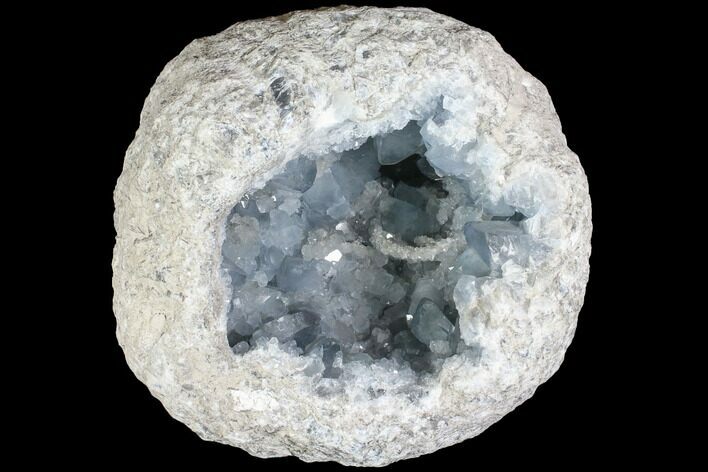This Specimen has been sold.
Huge, 10.7" Celestine (Celestite) Geode (45 Lbs) - Top Quality
This is a large, top quality celestine geode from Madagascar. It measures 10.7" wide, weighs 45 lbs and has a deep pocket of large, high grade Celestine crystals. An exceptionally nice specimen.
There is a small hole in the back of the geode that's worth mentioning, for it allows light within the geode, as well provides a good spot for back lit presentation.
There is a small hole in the back of the geode that's worth mentioning, for it allows light within the geode, as well provides a good spot for back lit presentation.
About Celestite
Celestite (or celestine) is a mineral consisting of strontium sulfate (SrSO4). It tends to form attractive, well-shaped crystals that are often found inside of geodes. One of the main sources of celestine is the deposits on the northwestern coast of Madagascar.
This famous Madagascar locality discovered in 1967 annually produces about 15 tons of the material. It is located near the village of Sakoany, on the western side of the banks of the Betsiboka River along Madagascar's northwestern coast. The celestine-bearing layer is found in a maximum 30-meter thick lens between layers of crinoidal limestones and sandy greywacke from the end of the Cretaceous. It is mined by digging shafts up to 15 meters (50 feet) deep to reach the deposits. The celestine occurs mainly as 2 different types: as geodes up to a maximum size of 60 cm in diameter, and as crystal clusters up to 15 cm in diameter.
The world's largest known geode is 35 feet (10.7 m) in diameter at its widest point with celestine crystals reaching 3 feet wide, and is located near the village of Put-in-Bay, Ohio. The geode has been converted into a viewing cave, Crystal Cave.
Celestite (or celestine) is a mineral consisting of strontium sulfate (SrSO4). It tends to form attractive, well-shaped crystals that are often found inside of geodes. One of the main sources of celestine is the deposits on the northwestern coast of Madagascar.
This famous Madagascar locality discovered in 1967 annually produces about 15 tons of the material. It is located near the village of Sakoany, on the western side of the banks of the Betsiboka River along Madagascar's northwestern coast. The celestine-bearing layer is found in a maximum 30-meter thick lens between layers of crinoidal limestones and sandy greywacke from the end of the Cretaceous. It is mined by digging shafts up to 15 meters (50 feet) deep to reach the deposits. The celestine occurs mainly as 2 different types: as geodes up to a maximum size of 60 cm in diameter, and as crystal clusters up to 15 cm in diameter.
The world's largest known geode is 35 feet (10.7 m) in diameter at its widest point with celestine crystals reaching 3 feet wide, and is located near the village of Put-in-Bay, Ohio. The geode has been converted into a viewing cave, Crystal Cave.
SPECIES
Celestine (Celestite)
LOCATION
Sakoany, Boeny, Madagascar
SIZE
10.7" wide, 10.3" tall, 8.3" deep, 45 lbs
CATEGORY
ITEM
#87137
 Reviews
Reviews
















